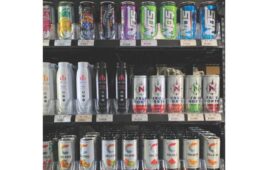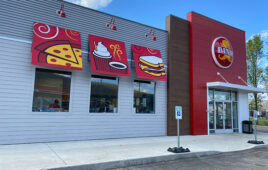The popularity of e-cigarettes has risen substantially over the past couple of years, giving retailers an opportunity to make up for shrinking tobacco profits.
By Frank Seltzer, Contributing Editor.
Electronic cigarettes are a relatively new product, but for convenience stores they are beginning to make a big impact on sales. Electronic cigarettes were invented just eight years ago in 2003 by a Chinese pharmacist. Three years later they became a commercial product. Most of the devices have three basic components—a battery, an atomizer and a mouthpiece cartridge, which contains a solution.
The solutions allow for the disbursement at different levels of nicotine, depending on the concentration of the solution, or no nicotine at all. The solutions can contain flavors like tobacco, mint, apple, coffee, vanilla or menthol. The atomizer turns the solution into a vapor that the user inhales. Most of the devices look just like regular cigarettes, but others look like pens or even screwdrivers. The users say they are “vaping” rather than smoking.
At first, the e-cigs, as they are called, were marketed and sold primarily in Europe. By 2009, an estimated 300,000 people were regularly using e-cigs. In the U.S., manufacturers faced the hurdle of the Food and Drug Administration (FDA) when it took action against the e-cig makers.
In 2009, the FDA decided e-cigs were drug delivery devices and ordered five American marketers to stop selling them. A court battle ensued and the e-cig makers prevailed in the lower court and again with a 3-0 appeals court win in December 2010. That decision has had a tremendous impact given that at the recent Tobacco Plus Expo, no less than 18 e-cigarette companies were displaying their products and many of the companies were under a year old. However, some municipalities and states are considering legislation to put limits or bans on the product.
Until recently, e-cigs have been sold through traditional tobacco stores that normally expect a keystone or 100% markup on items other than cigarettes. Though it is hard to determine the number of e-cig users in the U.S., the National Vapers Club estimated that about a million people used e-cigs last year, so it certainly is a growing segment, and the product offers c-stores an excellent alternative to cigarettes with lower taxes and much higher margins. Smoker Friendly in Grand Junction, Colo., for example, moves about 15-20 e-cigarettes a month with prices of around $70 each.
Understanding E-Cigarettes
There are basically two types of e-cig products. The first is a disposable e-cigarette. The premise of this product is that a consumer buys a one-time use e-cig and when they are done they throw it away. Most of the disposable e-cigs are the equivalent of at least two packs of regular cigarettes, depending on the habits of the smoker. The retail price for most disposable e-cigs is about $10. The wholesale costs vary depending on the quantity ordered, but generally they are at least half the suggested retail price.
For convenience stores, this offers a margin much higher than that of regular cigarettes. Also, as of presstime, there are no tobacco taxes on the e-cigs because there is no tobacco in the product, which can make it a very affordable alternative to cigarettes in high tax areas, leading to even more sales.
The other e-cigarette option is the rechargeable e-cig. These come in a variety of forms and carry a higher entry price. With these products, the initial pack can cost from as little as $30 to well over $200 at retail, putting it on the high side for a convenience store. But the kits vary, giving customers one or more batteries with multiple chargers and several cartridges. Some kits even have additional batteries built into the cases, allowing the user to recharge the cigarettes between each use.
A recent study by Boston University School of Public Health showed that e-cigarettes may hold promise as a smoking-cessation method because they address two aspects of smoking: the nicotine and the behavioral habit of puffing. The limited study used a survey of 5,000 first-time buyers of e-cigarettes from one company over a two-week period. The results showed that 68% of the first-time users were able to reduce the number of cigarettes they smoked.
Many of the e-cigs look just like regular cigarettes, but they also come in many colors. While many have automatic switches activated by drawing on the e-cigarette, others have manual buttons that can be pushed to activate the vaping. The combinations are almost mind-boggling. The idea of the rechargeable packs is that customers will come back to purchase the refill cartridges, giving stores a continuing source of revenue.
Most of the refills retail for about $10 for a five pack, which would be the equivalent of five packs of regular cigarettes. This can be excellent for c-store operators, but dicey for the consumer, as most of the rechargeables are not compatible with each other. Therefore, the customer must find the store that sells his brand.
Naser Nayeb, operator of Stop and Shop stores in Garland, Texas, as well as several tobacco stores around the Dallas area, said he does not sell e-cigarettes in his convenience stores yet, but is considering it. His tobacco stores, on the other hand, do sell the product, which is doing exceedingly well. His rationale for selling the e-cigs exclusively at his tobacco shops and not at his c-stores is that he mostly sells the rechargeable e-cigs, and in doing so gets a lot of customer questions about the products, which is fine for a tobacco shop, but the time involved answering questions in a c-store can really slow things down.
Currently, his tobacco stores are on back order trying to keep up with demand for the $89.99 rechargeable.
“Once Rush Limbaugh started talking about e-cigarettes on his show, the stores could not keep up,” Nayeb said. “We would get in three cases and immediately re-order up to three times in a week.”
Nayeb’s tobacco stores started carrying e-cigs about a year and a half ago. He said the early models he got in had problems with both taste and reliability. Today, he is satisfied with the quality of the products and is considering adding disposable e-cigs to his c-stores because other chains are also hopping on the electronic bandwagon. “7-Eleven is pushing hard on the e-cigs right now, so I might do it as well,” he added.
Paul Kandhari, a 7-Eleven franchisee with seven stores in New York City, said he sells the e-cigs, but they “are not exactly flying off the shelves” in his market despite the fact that e-cigarettes are more affordable than a pack of cigarettes, which now costs about $14 in New York due to all the taxes.
Kandhari sells two different types of disposable e-cigs with different price points. One is about $10 while the other is just under $20, and both have very good margins. Ironically, he said, the more expensive one is selling better. His customers like the higher priced product because one e-cig is the equivalent of up to three packs. The key, Kandhari believes, is finding the right product for the market.
For Rutter’s Farm Stores in York, Pa., e-cigarettes are a very new item, and the chain is moving cautiously. Robert Perkins said the company has just begun testing sales of disposable e-cigs, which have the advantage of a lower entry price, in 10 of their 55 locations.
Perkins likes the small footprint of the disposables, the price point of under $10 and its packaging that allows him to display it by the register. While it is too early in the testing to gain any real idea of results, the e-cigs are moving. In the first month of the test, one store already has re-ordered two more 24-count boxes, proving that the e-cigs can drive sales.
E-cigarettes could be a good addition to any c-store’s planogram. The key is to do the research, test several models and find the right product for your market and customers.




